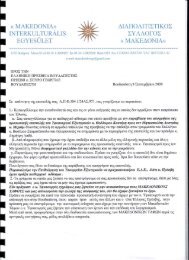Görög Örökség Ελληνική Κληρονομιά - H-ellin.com
Görög Örökség Ελληνική Κληρονομιά - H-ellin.com
Görög Örökség Ελληνική Κληρονομιά - H-ellin.com
You also want an ePaper? Increase the reach of your titles
YUMPU automatically turns print PDFs into web optimized ePapers that Google loves.
Byron'(oil), 'Dobozy and his wife'(oil) etc. The 'Dobozy' painting is very popular and many artists<br />
painted in the same style. No matter how many topics Lakkataris painted, he remained known as a<br />
portrait painter.<br />
He participated in the Hungarian revolution in 1848 and created a lot of paintings inspired<br />
by the war of the revolutionaries. In 1849 he was self-exiled in Graz; a few years later he returned in<br />
Pest where he died in 1864 on Christmas Day<br />
Sterio Károly(1821-1862) Stergiou Carolos (Charles)<br />
He was born in 1821 in Soaszkabanya. He studied in the Academy of Vienna in 1838 and later in<br />
Munich, France and Italy. In 1840 he settled in Pest where the people embraced his art.<br />
His paintings consist of many portraits, paintings and watercolor. One of his most important<br />
paintings is 'Feszl Frigues' in 1847 that shows him sitting on his armchair; this painting is one of the<br />
best of the 19' century.<br />
Another very popular painting of his is 'Zschenyi Stefan', a colored lithograph which shows<br />
him sitting on the back of the horse, with the coast of Pest on the background, next to the Chain<br />
Bridge, aiming at showing that he is the owner of the whole area.<br />
Sterio Karoly also painted moments of the Hungarian revolution, such as the work 'Klapka<br />
György'. In the Andrassy palace in Betler, there are many lithographs of the artist among which two<br />
display the Hungarian revolution of 1848-1849. In 1850 he made the painting 'Dembinsky's escape'.<br />
The painting provokes feelings of sentiment which are shown on the faces of the revolutionaries<br />
during their withdrawal and more precisely on the faces of the colonel and his soldiers. With these<br />
paintings the painter also be<strong>com</strong>es a historiographer and a writer of literature manners.<br />
Sterio is considered the prime mover of the Hungarian literature of manners. Along with Barabás<br />
Miklós and Weber Henrick in 1855 they make a volume entitled 'From the life of the Hungarian<br />
Nation' which is published by Pronay Gabor. In this volume the daily life of the Hungarian people is<br />
displayed in twenty-five illustrated paintings. His Greek origin is conveyed and shown in forty-<br />
eight icons that he made in 1857-58 in Pest for the church on Sérv utca street. In those icons he has<br />
beautifully <strong>com</strong>bined the orthodox with the western arts.<br />
Nákó Berta' A pale face with the look of Greek beauty'.<br />
She is the wife of the Greek Nákós Kalman, born in Gyertyanffy from Hungarian parents.<br />
She gained great reputation as a writer of literature manners in the 19' century mainly for the lives of<br />
the gypsies which she displayed on her paintings. She also had a private gypsy band in which she<br />
participated as a singer in the local fairs with her great voice and aristocratic appearance.<br />
After the death of her father-in-law, Nákó Sándor in 1848 the whole family moved to Vienna and<br />
stayed in their palace in Dorotheergasse street number 14. There, they formed a cultural<br />
environment which was pleasantly attended by their acquaintances. With her paintings she created a<br />
new style, though she was self-taught.<br />
Nákó János<br />
He is not a member of the famous Nákós family and unfortunately we do not know much<br />
about him and his family. He was working in Pest in the period 1840-1850. In 1840 he made the<br />
painting 'Marine landscape' and in an exhibition in 1842 he displayed the painting the 'Shipwreck'.<br />
Cárolos (Charles) Lyka(1869-1965)<br />
He studied painting in the Academy of Munich and after the end of his studies he gave up<br />
painting in order to be involved in History and Art reviewing. Until today, he is considered to be the<br />
best arts critic and writer bequeathing a great amount of exceptional work. Only one self-portrait is<br />
known of his paintings. With Cárolos Lyka is <strong>com</strong>pleted the presence of the Greek painters in<br />
Hungary in the 19 th century.<br />
While studying the painters of Greek origin we realize that they were following the same artistic<br />
path with their local partners for the last hundred years. This historic bond has always kept us<br />
united.<br />
137




